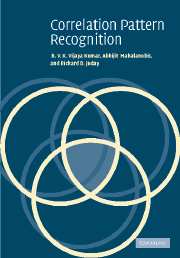Book contents
9 - Application of correlation filters
Published online by Cambridge University Press: 06 August 2009
Summary
The preceding chapters have described the techniques for designing correlation filters and their underlying mathematical foundations. The objective of this chapter is to provide a better understanding of the end-to-end process of designing and applying correlation filters to solve a pattern recognition problem. To facilitate this process we discuss two examples. The first is geared towards the recognition of targets in synthetic aperture radar (SAR) imagery. For this purpose, we use the public MSTAR SAR data set [3]. Details of a sample pseudo-code needed to construct and apply the filters to this data set are also provided. The second example discusses applications of correlation filters for face verification. Face recognition is just one example of a growing research field called biometric recognition [92] which includes other biometrics such as fingerprint, iris, etc. Correlation filters should prove useful in all such image recognition endeavors.
Correlation filters can be used to recognize patterns in images generated by many different types of sensors. Once the sensed information is converted into image pixels, the correlation pattern recognition algorithms can be applied in a fairly universal fashion. Thus correlation filters can find uses in all areas of automation including industrial inspection, security, robot vision, space applications, and defense. For instance, systems have been developed for fingerprint recognition [93]. Although the choice of sensor depends on the phenomenology associated with the pattern recognition/machine vision problem of interest, the approach for designing correlation filters generally remains the same.
- Type
- Chapter
- Information
- Correlation Pattern Recognition , pp. 357 - 382Publisher: Cambridge University PressPrint publication year: 2005
- 1
- Cited by



